Futuristic concept cars, plug-in hybrids, zero-emission electric vehicles and even a hydrogen-powered scooter jostled for the limelight as the Tokyo Motor Show kicked off yesterday.
From a super-skinny Nissan electric car that leans when going around bends, to a lightweight Toyota sports car and a Daihatsu vehicle with a design based on a basket, Japanese makers showed off their visions of the future.
While hybrids are still a big feature, electric cars are competing for attention at this year’s show as technological breakthroughs in rechargeable batteries bring mass-produced zero emission cars closer to reality.
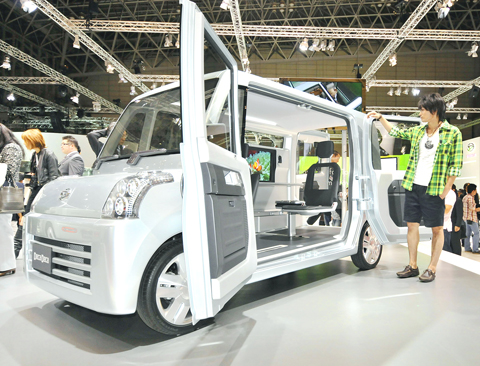
PHOTO: AFP
Foreign makers are almost entirely absent at this year’s show, now dominated by the Japanese makers, which are pinning their hopes on growing interest in fuel-efficient automobiles to rescue them from a brutal industry slump.
Toyota, the world’s largest automaker, displayed a new version of its electric concept car, the FT-EV II, as well as a Prius plug-in hybrid.
The pioneer of hybrids thinks that such vehicles, which have a petrol engine and an electric motor, will be “the core of the auto market in the future,” Toyota Motor president Akio Toyoda said.
But he said: “Toyota is not limiting itself to gasoline-electric hybrid vehicles. The era of reinventing the automobile is nearly upon us.”
Toyota also showed off a new lightweight, concept sports car inspired by the iconic Corolla AE86 coupe of the 1980s, along with a Lexus two-seat supercar with a 4.8-liter engine and a price tag of about US$375,000.
Sales of the Lexus, which is set to go into production next year, will be limited to just 500 worldwide.
Nissan meanwhile unveiled a concept car that leans to the side when going around bends. Just 1.1m wide, the “Land Glider” seats two people — one in the front and one in the back. Inspired by motorbikes and glider aircraft, it has tilting wheels that enable it to lean by up to 17 degrees. Nissan says it may start selling the car if there is enough interest.
It will also put its Leaf plug-in electric car on public display for the first time at the show, which opens to general visitors near Tokyo on Saturday and runs until Nov. 4. The mid-sized car will go on sale late next year.
“Leaf will make waves in our industry as the world’s first affordable zero-emission car,” Nissan chief executive Carlos Ghosn said.
“The time is now for zero emissions. Sustainable mobility is within our reach. We stand on the threshold of a new era in the automotive industry,” he said.
While Nissan lags behind its bigger rivals in hybrids, it is one step ahead in electric cars. Toyota has said it aims to launch an electric car by 2012.
From Honda comes the EV-N, a new electric concept car with a retro look that can store a one-wheel personal mobility device inside its door.
Fuel cells, which run on hydrogen and emit only water, also make an appearance at the Tokyo show as Honda and Suzuki put on display cars powered by the technology.
There is even a fuel-cell scooter and a fuel-cell wheelchair from Suzuki.
Proponents of hydrogen-powered vehicles say they are the only true zero emission technology as fossil fuels are often burned to generate electricity, particularly in emerging countries like China and India.
While the high production cost of fuel-cell vehicles poses a significant challenge, some think they may eventually overtake plug-in electric cars.
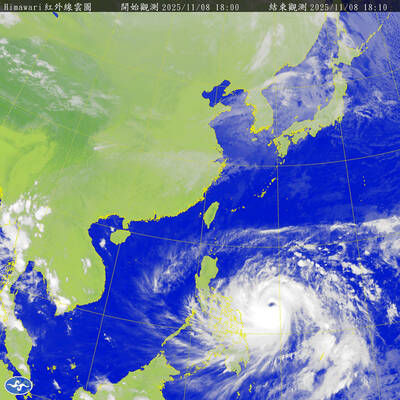
The Central Weather Administration (CWA) yesterday said it expected to issue a sea warning for Typhoon Fung-Wong tomorrow, which it said would possibly make landfall near central Taiwan. As of 2am yesterday, Fung-Wong was about 1,760km southeast of Oluanpi (鵝鑾鼻), Taiwan’s southernmost point, moving west-northwest at 26kph. It is forecast to reach Luzon in the northern Philippines by tomorrow, the CWA said. After entering the South China Sea, Typhoon Fung-Wong is likely to turn northward toward Taiwan, CWA forecaster Chang Chun-yao (張峻堯) said, adding that it would likely make landfall near central Taiwan. The CWA expects to issue a land
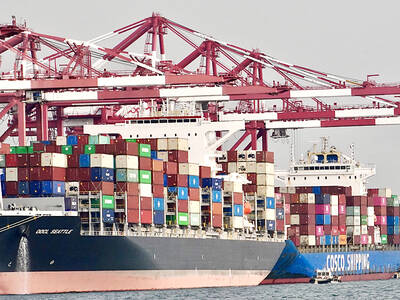
Taiwan’s exports soared to an all-time high of US$61.8 billion last month, surging 49.7 percent from a year earlier, as the global frenzy for artificial intelligence (AI) applications and new consumer electronics powered shipments of high-tech goods, the Ministry of Finance said yesterday. It was the first time exports had exceeded the US$60 billion mark, fueled by the global boom in AI development that has significantly boosted Taiwanese companies across the international supply chain, Department of Statistics Director-General Beatrice Tsai (蔡美娜) told a media briefing. “There is a consensus among major AI players that the upcycle is still in its early stage,”
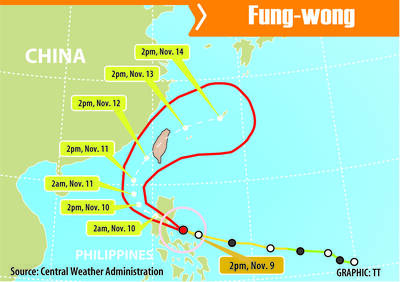
The Central Weather Administration (CWA) yesterday said it is expected to issue a sea warning for Typhoon Fung-wong this afternoon and a land warning tomorrow. As of 1pm, the storm was about 1,070km southeast of Oluanpi (鵝鑾鼻), Taiwan’s southernmost point, and was moving west-northwest at 28 to 32kph, according to CWA data. The storm had a radius of 250km, with maximum sustained winds of 173kph and gusts reaching 209kph, the CWA added. The storm is forecast to pass near Luzon in the Philippines before entering the South China Sea and potentially turning northward toward Taiwan, the CWA said. CWA forecaster Chang Chun-yao (張峻堯) said
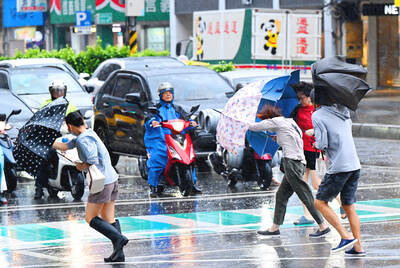
PREPARATION: Ferry lines and flights were canceled ahead of only the second storm to hit the nation in November, while many areas canceled classes and work Authorities yesterday evacuated more than 3,000 people ahead of approaching Tropical Storm Fung-wong, which is expected to make landfall between Kaohsiung and Pingtung County this evening. Fung-wong was yesterday morning downgraded from a typhoon to a tropical storm as it approached the nation’s southwest coast, the Central Weather Administration (CWA) said, as it issued a land alert for the storm. The alert applies to residents in Tainan, Kaohsiung, Pingtung and Taitung counties, and the Hengchun Peninsula (恆春). As of press time last night, Taichung, Tainan, Kaohsiung, and Yilan, Miaoli, Changhua, Yunlin, Pingtung and Penghu counties, as well as Chiayi city and county had